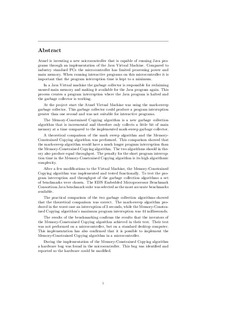| dc.contributor.advisor | Natvig, Lasse | nb_NO |
| dc.contributor.advisor | Haaker, Morten | nb_NO |
| dc.contributor.author | Amundsen, Kai Kristian | nb_NO |
| dc.date.accessioned | 2014-12-19T13:32:54Z | |
| dc.date.available | 2014-12-19T13:32:54Z | |
| dc.date.created | 2010-09-03 | nb_NO |
| dc.date.issued | 2005 | nb_NO |
| dc.identifier | 348039 | nb_NO |
| dc.identifier | ntnudaim:973 | nb_NO |
| dc.identifier.uri | http://hdl.handle.net/11250/250898 | |
| dc.description.abstract | Atmel is inventing a new microcontroller that is capable of running Java pro- grams through an implementation of the Java Virtual Machine. Compared to industry standard PCs the microcontroller has limited processing power and main memory. When running interactive programs on this microcontroller it is important that the program interruption time is kept to a minimum. In a Java Virtual machine the garbage collector is responsible for reclaiming unused main memory and making it available for the Java program again. This process creates a program interruption where the Java program is halted and the garbage collector is working. At the project start the Atmel Virtual Machine was using the mark-sweep garbage collector. This garbage collector could produce a program interruption greater than one second and was not suitable for interactive programs. The Memory-Constrained Copying algorithm is a new garbage collection algorithm that is incremental and therefore only collects a little bit of main memory at a time compared to the implemented mark-sweep garbage collector. A theoretical comparison of the mark sweep algorithm and the Memory- Constrained Copying algorithm was performed. This comparison showed that the mark-sweep algorithm would have a much longer program interruption than the Memory-Constrained Copying algorithm. The two algorithms should in the- ory also produce equal throughput. The penalty for the short program interrup- tion time in the Memory-Constrained Copying algorithm is its high algorithmic complexity. After a few modfications to the Virtual Machine, the Memory-Constrained Copying algorithm was implemented and tested functionally. To test the pro- gram interruption and throughput of the garbage collection algorithms a set of benchmarks were chosen. The EDN Embedded Microprocessor Benchmark Consortium Java benchmark suite was selected as the most accurate benchmarks available. The practical comparison of the two garbage collection algorithms showed that the theoretical comparison was correct. The mark-sweep algorithm pro- duced in the worst case an interruption of 3 seconds, while the Memory-Constrained Copying algorithm's maximum program interruption was 44 milliseconds. The results of the benchmarking confirms the results that the inventors of the Memory-Constrained Copying algorithm achieved in their test. Their test was not performed on a microcontroller, but on a standard desktop computer. This implementation has also confirmed that it is possible to implement the Memory-Constrained Copying algorithm in a microcontroller. During the implementation of the Memory-Constrained Copying algorithm a hardware bug was found in the microcontroller. This bug was identified and reported so the hardware could be modified. | nb_NO |
| dc.language | eng | nb_NO |
| dc.publisher | Institutt for datateknikk og informasjonsvitenskap | nb_NO |
| dc.subject | ntnudaim | no_NO |
| dc.subject | SIF2 datateknikk | no_NO |
| dc.subject | Program- og informasjonssystemer | no_NO |
| dc.title | Java Virtual Machine - Memory-Constrained Copying: Part 1: Main report | nb_NO |
| dc.type | Master thesis | nb_NO |
| dc.source.pagenumber | 110 | nb_NO |
| dc.contributor.department | Norges teknisk-naturvitenskapelige universitet, Fakultet for informasjonsteknologi, matematikk og elektroteknikk, Institutt for datateknikk og informasjonsvitenskap | nb_NO |
